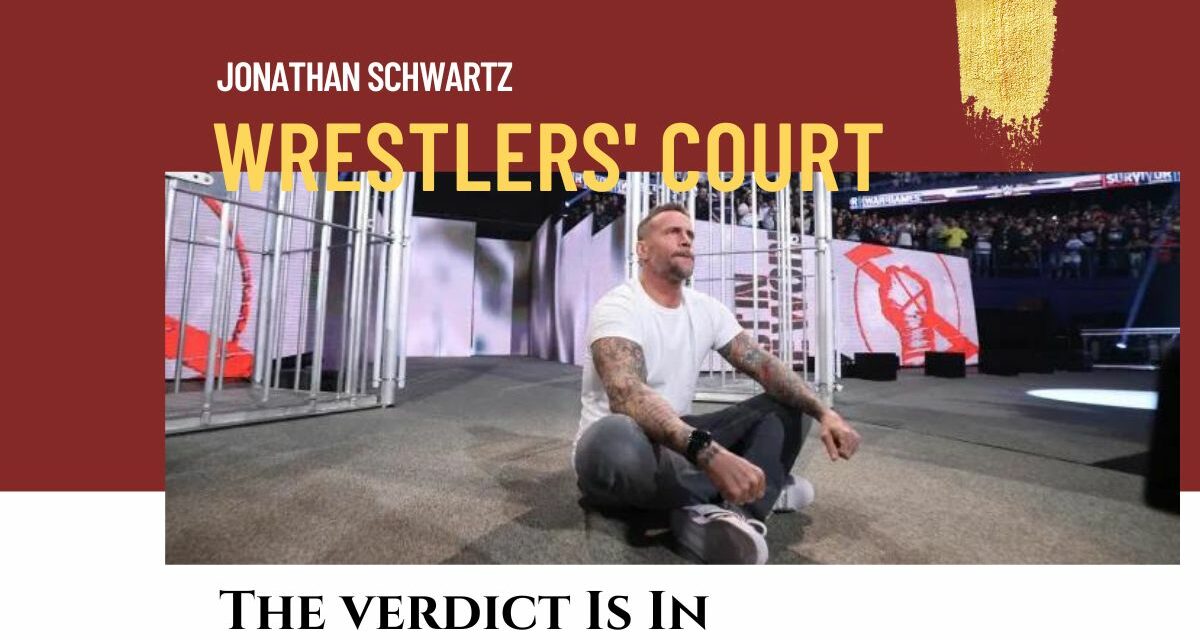Perhaps the biggest truism in professional wrestling, especially WWE, is ‘never say never’. It seems like no matter what happens if there’s money to be made WWE will put aside even the harshest differences and do business with just about any talent — eventually.
On Saturday, November 25, Hell froze over… at least in pro wrestling terms. After nine years away from WWE (and seven years removed from pro wrestling in general), Phil ‘CM Punk’ Brooks returned to the Survivor Series Premium Live Event in his hometown of Chicago. Following a crackerjack card which already boasted Randy Orton’s return from injury to the main event War Games match — and R Truth coming back to eat a bag of potato chips — Punk emerged from backstage to a thunderous ovation. Is there any modern wrestler who’s as over in his hometown as Punk is in Chicago?
WWE had been teasing the return for weeks even though Punk reportedly signed with the company just before bell time. A series of promos by Shinsuke Nakamura along with a Go2Sleep finisher or two raised expectations but were oblique enough that WWE could pivot to a different opponent if the deal hadn’t gotten done. In fact, Nakamura would shift to a feud with Cody Rhodes on Monday’s RAW, adding red mist to his arsenal of Asian Wrestler Tropes.
Punk’s arrival backstage was kept secret and the roster, which has privately expressed mixed feelings about the situation, was reportedly kept in the dark. Punk did what he had to do in his first appearance back: very little beyond soaking in the love from the WWE Universe, along with the obligatory imaginary watch-check, “It’s Clobbering Time” taunt and micro stage dive into the audience. At least he didn’t break anything this time. He clocked the reactions of Seth Rollins and Drew McIntyre, both of whom seemed put off by this latest comeback into a crowded main event scene. Punk followed this massive moment with a promo to close out the November 27 edition of Raw. I’ll get to that in a bit.
Full disclosure: I had originally intended this column to include a rundown of famous instances where WWE and its predecessors had run afoul of top talent, including the likes of Bruno Sammartino, Bret Hart, the Ultimate Warrior and Randy Savage. There’s a lot to write on that subject (I mean a lot) so for the moment, I will stick to Punk’s return, which has captured the attention of wrestling and mainstream media.
I’ll be back with the usual deep dive. I promise.
Putting a pin in the broader issue of reconciliation between WWE and its discontents, one should consider how the promotion has managed to squash some of its biggest beefs with its brightest stars. A quick review shows a pattern. Where the dispute involves high-profile talent who could be seen as carrying the brand forward, it seems WWE will eventually take the steps necessary for rapprochement. There are plenty of former (and in some cases, like Goldberg or Hogan or Brock Lesnar, future) world champions who are welcomed back into the fold for the sake of historical completeness, another round of merchandise sales, or in-ring runs of varying quality.
The circumstances of each dispute and the behaviors leading to estrangement vary. In some examples the stakes were financial — wrestlers catch wind that they have been underpaid or prevented from maximizing their income during their limited time in the spotlight, which is unfair to supposed independent contractors. In other instances creative decisions became an insurmountable issue, especially where control over one’s character is a contractual term. The hardest cases bleed over from the fictional world of pro wrestling to the real-world consequences of an amoral industry. Wrestlers wind up pushing themselves physically and psychologically beyond their limits for the sake of WWE’s profit, costing them personal relationships and occasionally even the lives of people they care about.
Viewed in the larger context of historical disputes between WWE and its headliners, CM Punk’s grievances against WWE are/were valid, but he’s hardly the first superstar to fall out, then fall back in.
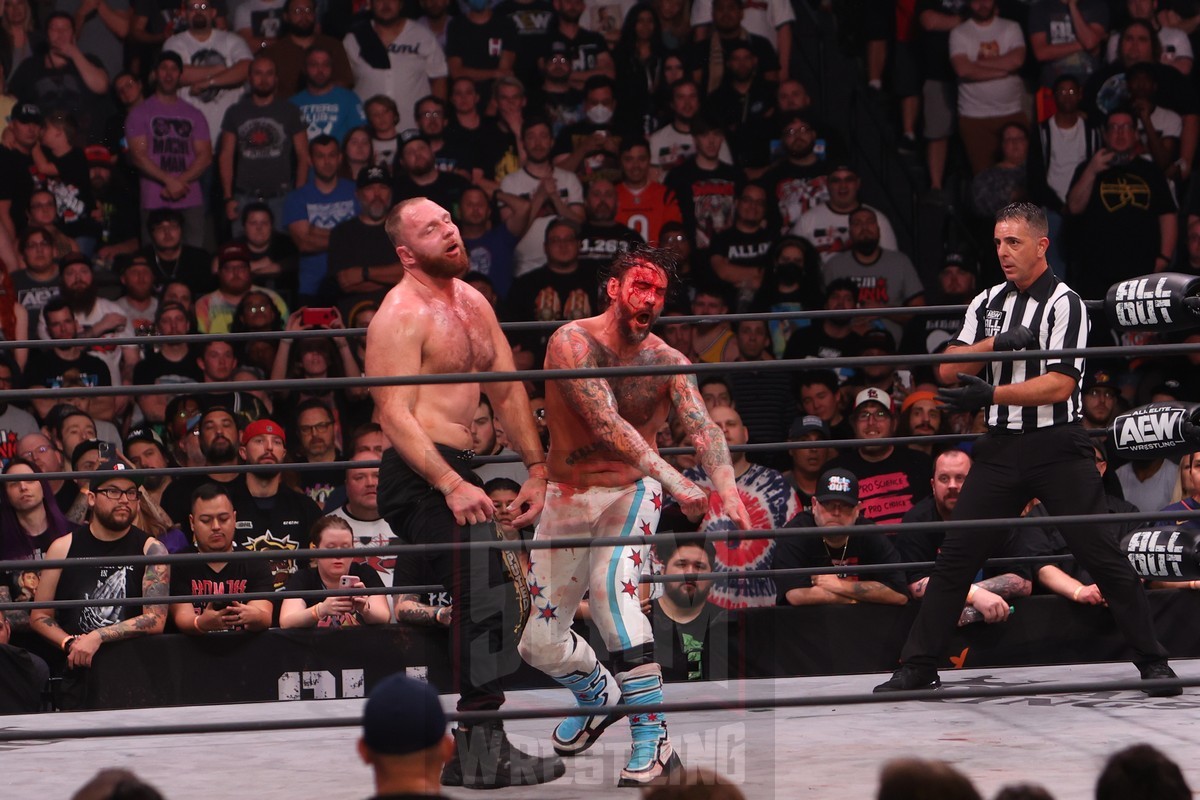
CM Punk vs. Jon Moxley (C) in an AEW World Championship Match at AEW All Out at the Now Arena, in Hoffman Estates, Illinois, Sunday, September 4, 2022. Photo by George Tahinos, https://georgetahinos.smugmug.com
I’ll acknowledge an apparent double standard. Returns like Punk’s are seen as inevitable, but then Punk was a WWE main event draw for years before he walked out of the company. He showed he could still pop a crowd and put people in seats when, after a seven-year hiatus he returned to pro wrestling at an All Elite Wrestling (AEW) card, also in Chicago. Punk has stayed relevant to the WWE universe throughout his estrangement. For the better part of a decade chants have echoed throughout arenas at house shows and on TV broadcasts. They continued through Saturday’s Supercard before the prodigal Punk returned. Contrast that with any number of wrestlers who populated WWE’s mid-cards and have been summarily forgotten. When I started writing this column I considered how many big-time returns followed lawsuits between WWF/WWF/WWE and its main eventers. Bruno Sammartino, Superstar Billy Graham, Ric Flair, Hulk Hogan, Sgt. Slaughter, Bret Hart and the Ultimate Warrior all sued the company yet have found their way back into WWE’s good graces (in some cases, like Graham and Flair, there have been serial reunions and falling outs). That said, approximately 60 wrestlers who participated in an ill-advised attempt to sue WWE for negligence arising from concussions allegedly suffered in-ring have largely been erased by WWE. This list includes includes pre-lawsuit WWE Hall of Famers like the Road Warriors, Paul Orndorff and Jimmy ‘Superfly’ Snuka. Wrestlers who would have been presumptive Hall of Famers like Ken Patera, Demolition (Bill Eadie and Barry Darsow), George ‘One Man Gang’ Gray and Angelo ‘King Kong’ Mosca are continually passed over. In Demolition’s case, WWE made a point of eclipsing their then-record tag team championship reign.
I am an unabashed CM Punk fan. I suspect this has to do with the fact that we are around the same age. Punk has styled himself as ‘the voice of the voiceless’, an idea that I think resonates strongly with members of Generation X. At his creative peak Punk could draw comparisons to the likes of ‘Rowdy’ Roddy Piper or ‘Stone Cold’ Steve Austin, wrapped up in a package designed to appeal to disaffected sellouts encroaching on middle age. Just like me.
Some fans think Punk’s act before the cameras and his conduct behind them has long since worn thin. For years Punk has had a mixed reputation behind the scenes. The WWE locker room was reportedly skeptical about his return. For the few days he’s been back he seems to be behaving himself. So much so that it’s now rumored that he has a Good Conduct clause written into his contract.
Others claim that they have grown tired of Punk’s penchant for airing his dirty laundry in public, including Punk’s lawsuit against former bestie Colt Cabana and his press-conference roast of Cabana and half the AEW locker room. The latter was one of several incidents that abbreviated Punk’s tenure there. I agree these events are problematic, especially where Punk is alleged to have legitimately assaulted his colleagues or threatened his bosses. Punk has also spent most of the last decade as a vocal opponent of his old/new employer — though in pro wrestling sometimes it’s hard to say how much is heartfelt versus a play for attention. In any case, I’m curbing my enthusiasm and suggest that you do the same. Punk’s current WWE run may well be short. I’m still happy to be along for the ride.
Punk’s promo on RAW felt safe. It was at odds with Michael Cole and Wade Barrett’s insistence throughout the broadcast that Punk was/is a controversial talent. If your exposure to pro wrestling was limited to WWE and you became a fan within the last nine years — when WWE did its usual job of pretending a disenchanted former star never existed — you’d hardly know what Punk can bring to the table.
I think he did exactly what he had to do, which was manage expectations in a newly rekindled business relationship.
From WWE’s perspective Punk’s return is an exercise in risk management and mitigation unless and until he shows that he’s back for the long haul. As encouraging as Punk’s Survivor Series pop must have been for WWE’s decision-makers, he brings a career’s worth of industry baggage with him into the WWE locker room. At this point Punk is penciled into programs with Seth Rollins and Roman Reigns. Win or lose this suggests a measure of confidence in Punk as a draw. It also puts him in with performers with whom he has considerable on-screen history (Rollins and Reigns debuted as two-thirds of the Shield faction, saving Punk from a savage beating by Ryback before Punk turned face to feud with them). Early top-line feuds maximize Punk’s impact in case this run proves short-lived, or if age or injury expose his limitations as a performer. I do wonder what they mean for WWE stars who are currently struggling to rise up the card, or who may see sustained pushes derailed in favor of what could turn out to be a short-lived nostalgia act. Cody Rhodes’ years long quest to ‘finish his story’ with a WWE championship began when he left AEW at the same time as Punk joined. LA Knight is seeing a late-career run that combines an Austin-Rock approach to promos with a John Bradshaw Layfield sense of urgency. At least JBL had a Superstar Graham-worthy run with a belt.
Even if Punk stays on his best behavior it’s worth noting that he left WWE in part because he was often hurt and unable to take time off to heal, then got fired on his wedding day, then sued WWE and its in-house physician Dr. Chris Amann for negligence — successfully, I might add. Fast forward a few years and alleged personal growth aside, Punk spent over nine months of his two years in AEW on the injured list.
WWE is smart to slow play Punk’s return.
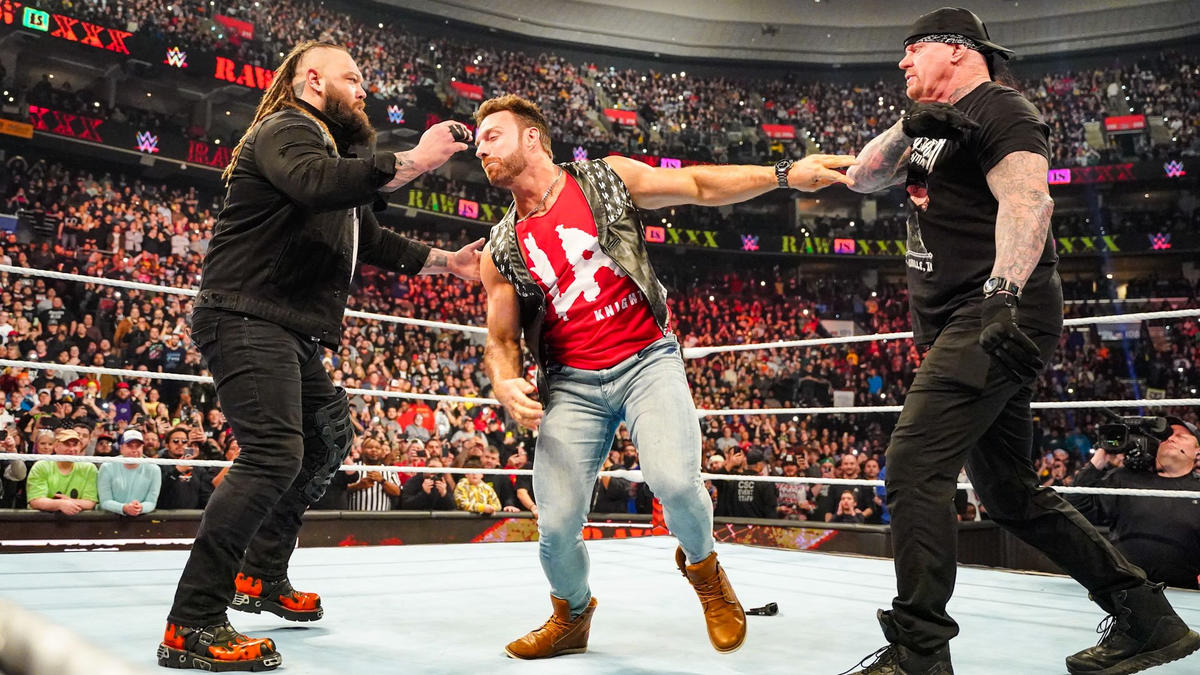
Bray Wyatt and Undertaker teach LA Knight a lesson. Courtesy: WWE.
The last time WWE fans exploded over a pay-per-view-ending walkabout was October 2022. Bray Wyatt came back after being released due to budget cuts over a year earlier. Wyatt was greeted with a rabid ovation following weeks of sophisticated teases on WWE programming. I was glad to see him, too. I think had he lived, he would have developed into an all-time great creative mind, and one who could back up his vision with his performances on the microphone and in the ring. WWE made significant investments in all phases of Wyatt’s production and long-form storytelling. His cryptic new character seemed to lose momentum quickly and then-WWE honcho Vince McMahon seemed bent on the kind of interference that precipitated Wyatt’s initial departure. All too soon Wyatt would be injured, then sick, then gone. I’m not saying Punk’s outcome will be nearly as unfortunate. I can understand WWE being cautious not to over-commit to a single character or performer when doing so could easily stymie long-term plans.
WWE is in a very different situation with Punk than they were, say, in 1996 when a desperate Vince McMahon tried to lure the Ultimate Warrior back from Parts Unknown to help in his battle against WCW. Today, Vince is mostly removed from WWE’s creative process. AEW is WWE’s highest-profile competition but not a threat, especially now that WWE is part of a much bigger corporate entertainment conglomerate. As I write this, WWE is allegedly negotiating to put its flagship Monday Night Raw show on the TNT cable network — currently home to AEW programming. WWE displacing AEW from TV would be bad for the industry as a whole; I hope it doesn’t happen.
WWE’s roster is stacked. It has the means to pursue any talent it wants. WWE and AEW give wrestlers two sets of deep pockets to frame negotiations. Impact/TNA Wrestling has made its fair share of generous offers even if it has come up short in bids for the likes of Punk and Will Ospreay. If a free agent chooses AEW, waiting that contract out isn’t a problem for WWE and it may help that wrestler increase their value. Most importantly, WWE has continued to evolve along the course set by Hulk Hogan’s early-1990s departure. Since the fallow years of the early ’90s, Vince and other WWF/WWE executives have ensured that no superstar is bigger than the brand itself. Whether Punk shows out or fizzles out there are plenty of draws on a given card. WWE has long since stopped advertising specific matches for its house shows. It sells out pay per views a year in advance with no performers announced. Punk is fungible just like every other WWE wrestler.
One may argue whether Punk actually needs WWE at this stage of his career. If he’s been careful with the money he’s earned to date and not frittered it away on lawsuits against former friends, he surely doesn’t need to risk injury or further loss to his reputation. There is no argument that WWE needs Punk. He’s service for a segment of their fan base, an incremental increase in occasional pay per view and merchandise revenues, and as long as he lasts, he is a feel-good story in a business that creates way too many tragic headlines.
Punk’s return to WWE is undoubtably big news. His momentary appearance at Survivor Series drew over 71 million views on social media. The initial excitement is huge but I would argue it will ultimately be short-lived. Punk has returned to the biggest wrestling company in the US with the greatest international reach and the strongest brand recognition. However, for his core fanbase, which I would suggest likely skews a bit older and is less invested in WWE marketing and more likely to follow multiple promotions, he’s already been back for a while.
For grown up fans the ‘real’ story’ took place when Punk ended his seven-year hiatus from wrestling to join AEW. At that time the real questions were whether Punk could still perform credibly as a professional wrestler after so much time entirely out of the business, and whether Punk’s exposure as a lousy ‘real fighter’ in a pair of Ultimate Fighting Championship (UFC) matches would hurt fans’ response to a grappler who’d always played off his supposed legitimate toughness.
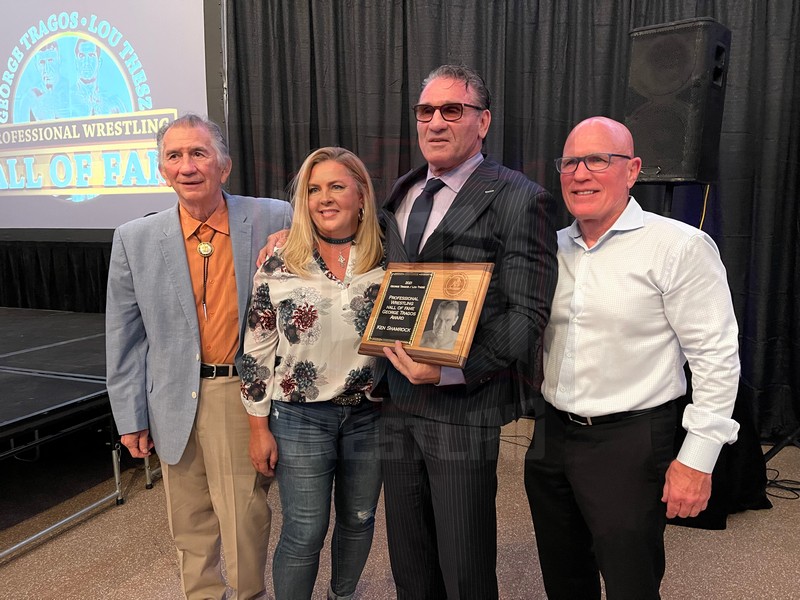
Gerry Brisco, Tonya and Ken Shamrock and the museum’s Jim Miller at the George Tragos/Lou Thesz Pro Wrestling Hall of Fame induction weekend, July 16-17, 2021, in Waterloo, Iowa. Photo by John Arezzi
Fans outside the WWE bubble have their answers to both questions. Punk is still able to go, although I think he is reaching a point where he may want to embrace doing less in his matches to secure hotter crowd reactions. His fans don’t care about his UFC record. If legitimate fighting skill really mattered in modern pro wrestling, Brock Lesnar and Bobby Lashley would be footnotes to the Roman Reigns style tenures of Ken Shamrock, Dan Severn and Tank Abbott. More to the point, if ‘actual’ wrestling mattered, we would still be following the sporting presentations of old-school NWA and AWA rather than watching their quaint, kayfabe-driven broadcasts on WWE’s Peacock stream. Up here in Canada, if you have access to two of our sports channels, you’ve seen what Punk can do in the ring and what his future opponents are doing in WWE. At least some of Punk’s value proposition at this stage of his career and given his history lies in the likelihood of this WWE run ending in another car crash.
Last time I wrote about Punk in the wake of his second AEW meltdown [Wrestler’s Court: Keep your hands to yourself]. I suggested that his outbursts either reflected a feeling that he was done with pro wrestling altogether, or that he may be facing serious health challenges linked to too many blows to the head. I presume that if he is going to perform in-ring, WWE has signed him following a more credible physical evaluation than he received from Dr. Amann. If so, concern over his health should not be an issue for now. Whether Punk is in a better headspace to finish his career on his own terms, time will tell. The key question is whether Punk and WWE have reconciled in time for one last truly productive run of great matches, or whether fans are just getting a half-speed collection of greatest hits.
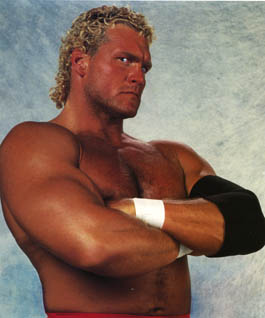
Sid Vicious
So how does WWE make the most of Punk’s second go-round? I not only suggest that WWE laid the groundwork for their approach to wayward superstars in how they handled the notoriously temperamental Sid ‘Vicious/Justice/Psycho’ Eudy, but that AEW and Tony Khan’s failure to take this approach to booking Punk over the last two years contributed to his physical and mental deterioration. Worse, I think that their insistence on featuring older talents with injury histories like Adam Copeland, Christian Cage or Bryan Danielson is setting those talents and the promotion up for a fall in terms of wrestler health, roster morale and long-term creative frustration.
So far as the Psycho Sid Approach goes, Bruce Prichard laid it out in an episode of Something to Wrestle. Like Punk, Sid was seen as equal parts draw and liability. Where Punk is perhaps overprotective of his vision for wrestling, Sid was openly disinterested apart from the money (Punk’s closing remarks on RAW notwithstanding). Both men became prone to injury over time and had other priorities that limited long-term booking options. Sid and Punk are both known to get into fights backstage. When Punk’s detractors express their surprise that WWE would hire him again, his supporters point out that WCW readily hired Sid back after he stabbed fellow wrestler Arn Anderson with a pair of scissors and tried to filet Double-A with a squeegee.
WWF also hired Sid more than once. After Sid’s first run ended acrimoniously, WWE learned how to take advantage of his short attention span. Sid would be booked into brief programs on an abbreviated touring schedule, understanding that he might no-show and another talent would have to carry his load. Sid got a pair of WWF championship runs even though he and the WWF each had an eye on the exit. He sold tickets and when he was done, he was done. The WWF grew to accept this and took advantage of these runs to help make newer bigger stars.
I’m repeating myself but Sid’s booking showed WWE and other promotions how to optimize big names with commitment issues. Goldberg, Batista, Edge and others have long worked shorter programs with an emphasis on TV and pay per views. They’re smartly booked against opponents who will readily bump for them, with minimal risk of injury or exposure. This approach works so well that WWE has begun applying it to established stars like Randy Orton or Roman Reigns, preserving their ‘bump cards’ for meaningful matches. It’s frustrating for fans who hope for fighting champions or take any sort of pro wrestling championship metrics or records seriously. I don’t know why one would complain about fabricated records in a fictional sport where results are predetermined. I think it’s a worthwhile trade if it prolongs careers and increases the chance that the wrestlers I love watching will live longer, healthier lives.
All this being said I’m happy to see Punk back in WWE.
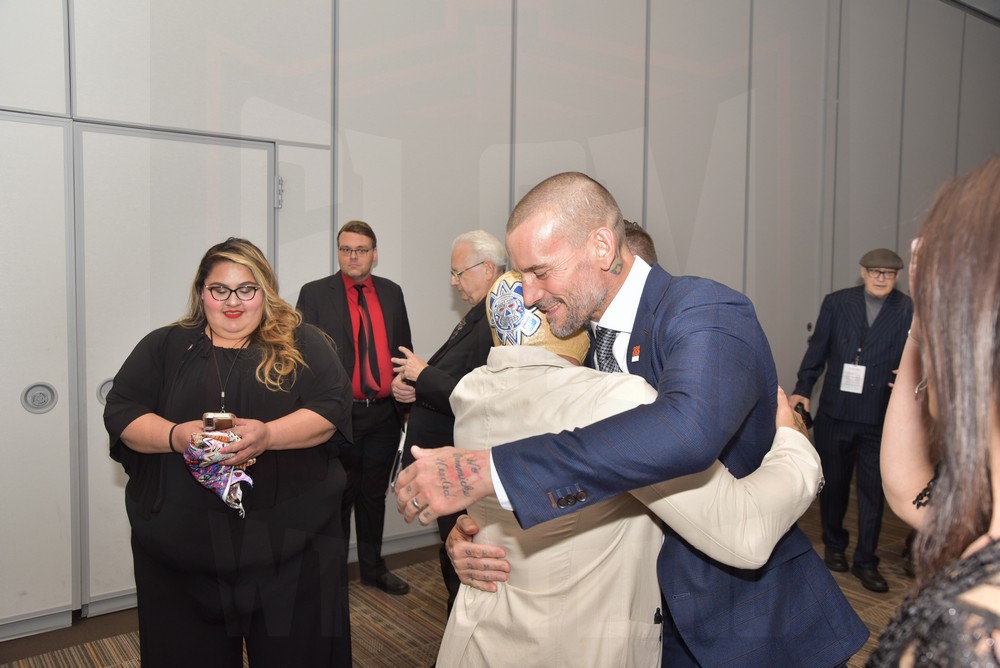
Rey Mysterio Jr. hugs CM Punk at the Cauliflower Alley Club banquet on Wednesday, August 30, 2023, at the Plaza Hotel & Casino in Las Vegas. Photo by Scott Romer
In Punk’s first promo back on RAW I detected two main themes.
The first and in my view most honest theme was set out in his opening line that Hell had frozen over and his near-decade long estrangement from WWE had ended. I think this was the line that fans like myself have been waiting for, even if it parroted WWE Head of Creative Paul Levesque’s social media posts following Survivor Series.
The second, and in my view slightly disingenuous theme was the idea that in coming back to WWE Punk is now ‘home’. As loved as he is by a segment of WWE’s audience, I don’t believe that WWE was ever Punk’s home.
I’ve mentioned how Punk reminds me of Roddy Piper and Steve Austin. Like those legends, Punk has defined himself as anti-authority and anti-corporate. His infamous worked-shoot ‘pipe bomb’ promo was effective because it tore down pro wrestling’s fourth wall and exposed some of the inequities inherent in the WWE machine.

Serena Deeb, CM Punk and Luke Gallows pledge allegiance to one nation, under Punk, at WrestleMania 26 at the University of Phoenix Stadium in Glendale, Arizona, on Sunday, March 28, 2010. Photo by Mike Mastrandrea
Restlessness is as much a trait of Punk’s character as wrestling. In Ring of Honor he had his ‘Summer of Punk’ World Championship run after he was revealed to have signed a developmental contract with WWE. Punk’s most famous WWE title run revisited (or copied, depending on your view of things) that storyline. As a champion Punk was intriguing because he carried the threat that he would move on, that his corporate employers needed him more than he needed them or their championships. It is alleged that one source of Punk’s frustration with WWE during his initial run was the company’s failure to slot him into a main event WrestleMania match. Mania has expanded to two nights, so he might just get that wish if things go well. I think what Punk meant went beyond the April payday. Tattooed, loud and cranky, Punk was never going to be ‘the guy’ with a superhero like John Cena around… but I think that’s part of his appeal. Having Punk and Cena as dueling headliners allowed WWE to split its audience and retain the interest of older fans who sought out promotions like ROH. In my late 20s and early 30s, before I had children, much of Cena’s cartoon appeal was lost on me. I sure appreciated Punk’s work and would pay to see him when WWE came to town. Punk might have finally had his moment as ‘the guy’ in AEW. I don’t think he loved it. Maybe he’s reconciled himself to how he can be better used and the value of a smaller, more enthusiastic swath of fandom.
As mentioned, WWE doesn’t need Punk. As an older talent coming back to a limited schedule, it’s unlikely that he will win many titles unless necessity dictates otherwise (say, in the event of an injury to current champs Reigns or Rollins assuming WWE decides not to pull the trigger on the likes of Cody Rhodes, LA Knight or Damien Priest). Punk tried to reformulate his statement about ‘coming home’ later in his promo, saying the WWE Universe-the fans-were really his home. This rings slightly less hollow — but again, it’s inconsistent with the contempt Punk has shown for the wisdom of crowds.
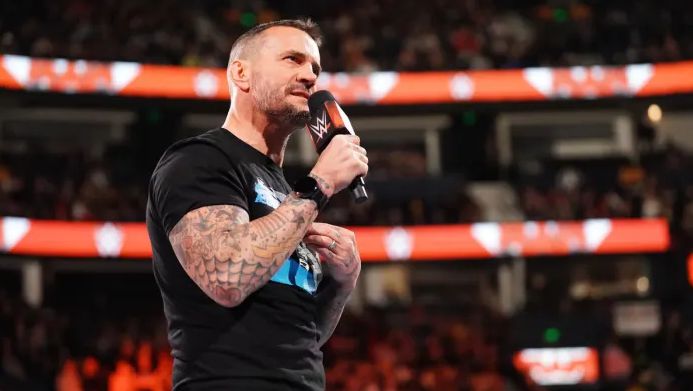
CM Punk makes his return to WWE Monday Night Raw on November 27, 2023, in Nashville. WWE photo
Punk’s best work during his 434-day reign as WWE champion was as a heel. He called out The Rock and John Cena. After his title reign ended he challenged the Undertaker at WrestleMania to a match he had no chance of winning and singlehandedly built a compelling feud (Undertaker was resigned to occasional appearances by this point and largely absent from the build for their match). Punk pushed the boundaries of wrestling’s version of good taste by mocking ‘Taker’s recently-deceased manager and real-life friend, William ‘Paul Bearer’ Moody. Punk gets into heated arguments with management. He allegedly gets into fistfights with colleagues backstage. He maintains a limited and snarky social media presence.
As he closed his promo, Punk stated his ultimate truth. After tossing the microphone away and covered by a newly remastered version of his theme song “Cult of Personality”, he said “I’m not here to make friends. I’m here to make money.” This was his first, veiled insult as AEW upon his return — tellingly obscured by the earlier mic drop. Without naming names, Punk called out what seems to be mounting evidence of unprofessionalism among AEW’s leadership trust. Of course, Punk’s own conduct leaves him open to the same claims — and means that even his biggest fans aren’t holding their breaths for a long goodbye.
With an eye to my next column, “I’m not here to be friends. I’m here to make money” is also the story of WWE and its prodigal performers. In fact, if that’s not pro wrestling in a nutshell I don’t know what is.
TOP PHOTO: CM Punk at Survivor Series 2023. WWE photo
RELATED LINK
